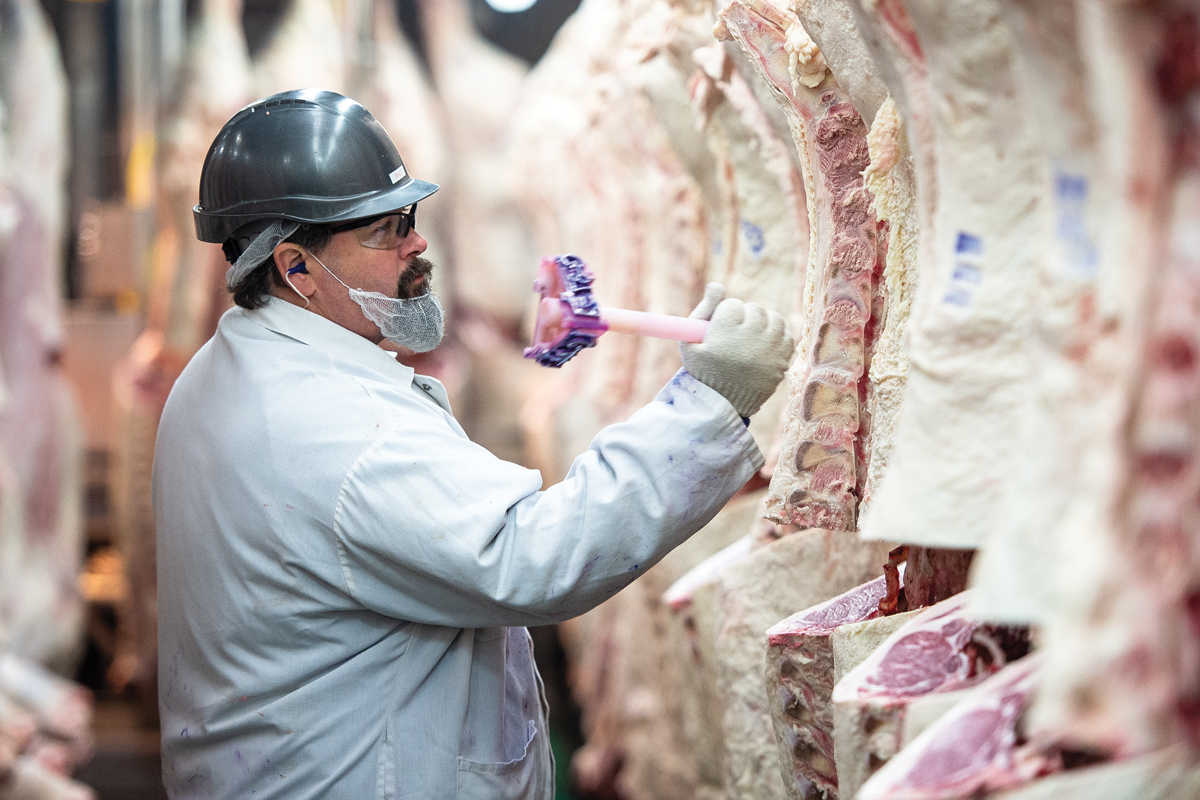Labor woes
Almost all meat processors cite labor as one of the top challenges they face in their operations. From competing employers and industries to a simple shortage of available workers in the area, labor continues to plague the meat and poultry processing industry. Beef packing facilities have yet to catch up with the pork and poultry industries in terms of implementing automated processing systems to offset the industry’s labor shortage.
Currently, automation in the beef processing industry consists of material handling, palletizers and robotics that run on PLC (programmable logic controllers). Manufacturers are experimenting with automation for the line. Mathew Trowbridge, director of operations at Creekstone, mentions a split saw from Jarvis that uses 3D imaging to hit the same spot on a carcass every time, but that technology has yet to hit the market.
“After it’s in a box, putting it away and then picking an order, you can do some automation on that side of it,” Rogers says.
With no real automation available to apply to actual production of the animal, Creekstone sought and found alternative ways to deal with labor issues it faces in beef processing. Similar to the way it handles the ever-changing daily fabrication schedule, the company works hard on innovative ways to incentivize employees, make its workers’ lives less complicated and make the company easier to appreciate.
According to a Creekstone report, 15 percent of Creekstone’s fabrication team lives in Wichita, Kansas. Creekstone worked with the city of Wichita, and starting on Feb. 26, a charter bus began to run from Wichita to Arkansas City and back in the morning with another in the evening running back down to Arkansas City and back to Wichita.

Driving the bus
The city of Wichita used the addresses of Creekstone’s fab team members in a GPS simulation to figure out the best bus routes for pickups and drop offs. Creekstone educated team members prior to the start of the project so everyone involved could be on the same page once the bus started running.
“From the first day it started, it was sold out,” Trowbridge says. “We have another bus coming online over the next couple of months as well and that one will be sold out too.”
Christine Tanner, marketing and brand manager at Creekstone adds, “It’s an advantage to us too that those team members were already driving, but a lot of times they were carpooling. So, if the person driving the carpool was sick or wasn’t going to work that day, then you might have six people not show up instead of one. This helps that continuity of labor as well.”
This program not only helps Creekstone and its employees, but also serves a need in Cowley County (Arkansas City and Winfield, Kansas). Once the bus from Wichita drops off in Arkansas City in the morning, it then travels to the Walmart in Arkansas City for a pick up, and then another in Winfield before heading back to Wichita. This serves a need for Cowley County residents in need of transportation to Wichita for medical appointments.
“Because of Creekstone they now have a bus that goes up to Wichita in the morning and then comes back in the evening,” Trowbridge says.
Creekstone subsidizes some and provides bus vouchers to team members before taxes.
The bus program from and to Wichita provides a value to Creekstone employees that transcends a monetary raise. While employees always welcome a raise, sometimes other options and benefits provide a greater value and more incentive to stay with the company.
“Everybody is paying more money. Money is a short-term solution,” Rogers says. “We have to look at doing things different or offering services that have a greater perceived value to that team member than a dollar an hour pay raise does.”
The executive team at Creekstone makes it a point to work on these types of benefits for its team members and continues to look for ways to add more benefits like the charter bus between Arkansas City and Wichita. One such program Creekstone would like to offer in the future involves making employees’ lives easier.
“We’re also looking at subsidized day care for hourly employees,” Rogers says. “From our perspective if we start at 6:00 a.m. and you have a child that needs to be dropped off at day care, you have to drop that child off at 5:30 a.m. Not a ton of options out there for day care that will take kids that early.”
Creekstone subsidized daycare would allow for a more flexible schedule on the pickup times for employees and their children. If something happens on the fabrication floor and the chain stops, it often means finishing the day’s run that much later in the afternoon. Employees might have to leave early or make emergency arrangements to pick up their children.
“So, we’re working on some options there to provide day care to our hourly associates to help with that,” Rogers says.
“It’s better to have that benefit than a higher hourly because it actually gives you back more in return,” Tanner says. “And, a lot of day cares will fine you if you’re late, every 15 minutes late is so much. To be able to have that flexibility and have it close, it’s a big thing for a lot of people, and it’s hard to find good day care too.”


